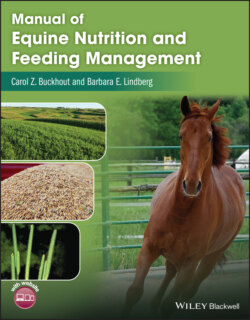Читать книгу Manual of Equine Nutrition and Feeding Management - Carol Z. Buckhout - Страница 10
ОглавлениеPreface
The suggested use for this manual is in an applied laboratory situation that allows students to have time to explore concepts as well as to work on class activities and assignments. It may serve as a companion document for an equine nutrition lecture course since key topics such as the six classes of nutrients and their functions as well as feeding strategies for various classes of horses are not included. A minimum of a two-hour time period is recommended in order for students to engage in each topic. The organization of the material fits with two key texts: Feeding and Care of the Horse, Second Edition, by Lon D. Lewis and Nutrient Requirements of Horses, Sixth Revised Edition, by the National Research Council (NRC). Both information and examples provided by Lewis along with nutrient requirements and feed profiles provided by the NRC are useful for completing many of the assignments. While the laboratory concepts and assignments build successively on each other, users of this manual may to choose to omit some labs or their exercises if time becomes a constraint. Alternatively, one may choose to extend the amount of time devoted to certain lab topics, especially Laboratory 1 on digestive anatomy. Assignments are designed to be thought provoking and practical. While answers to some lab questions are succinct, other questions are designed to support the concept that there is both a science and an art to the topic of equine nutrition. The authors acknowledge that there are many ways in which to engage students in the topic of feeding horses, especially now that fewer people have direct ties to production agriculture. The intention for this manual is to combine practical aspects of feeds and feeding along with more technical aspects of equine nutrition. In the end, may it bring our horses continued good health.
Carol Z. Buckhout
Barbara E. Lindberg
Disclaimer
The information in this lab manual was designed to help the horse owner understand practical aspects of equine nutrition and ration balancing. This, however, is only the beginning of understanding equine nutrition. New advances are being made every year, and therefore an astute horse owner will seek to stay current on recent research.
It should also be remembered that consultation with a veterinarian and/or equine nutritionist may be required in some instances. Nutrition should not be viewed as a standalone subject in a vacuum, but as a part of the holistic care of the horse.
